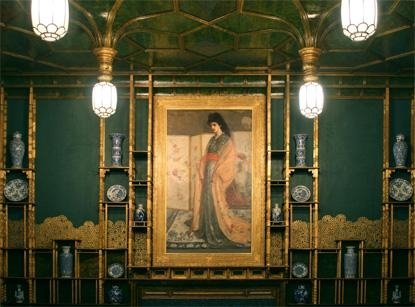Melvin Moti
dal 17/2/2010 al 24/4/2010
Segnalato da
17/2/2010
Melvin Moti
Wiels - Contemporary Art Center, Bruxelles
From Dust to Dust. The artist puts failure and dust at the center of a new project that is over one year in the making. Continuing the careful research that is central to his practice, the exhibition brings together a body of new works centred on a particular artwork-cum-decoration project called 'Harmony in Blue and Gold: The Peacock Room' (1876-1877) by the artist James Abbott McNeill Whistler. The resultant show is bracketed by an evocative constellation of objects, this new installation is formed around a central work, an abstract 35mm film: a mix of old-fashioned simplicity and futuristic scientificity.

Curated by Elena Filipovic Wiels curator
With the eye of an amateur detective-historian, and working with an intensity and slowness that is rare among artists of his generation, Dutch artist Melvin Moti (b. 1977) gives form to obscure anecdotes, incidents, and individuals—"black holes" that, as he says, "haven't been contextualized by official historiography."
For his first solo show in Belgium, Moti puts failure and dust at the center of a new project that is over one year in the making. Continuing the careful research that is central to Moti's practice, From Dust to Dust brings together a body of new works centred on a particular artwork-cum-decoration project called Harmony in Blue and Gold: The Peacock Room (1876-1877) by the artist James Abbott McNeill Whistler.
The resultant exhibition is bracketed by an evocative constellation of objects: a glass vial of 19th century dust; four photographs of Whistler's Peacock Room, each image lined with engraved glass showing moiré patterns in gold; two ornate pedestals; a "purple heart" decoration hung from its characteristic moiré fabric; two new drawings that had been subject to an aging machine so as to appear every bit as if they were made over a century ago; an actual Sir Joshua Reynolds' portrait of a certain Mary Barnardiston (Portrait of Mary Barnardiston, 1750) whose fading ghost-like skin on her hands and face (the only parts the famous portraitist actually painted himself since he had his assistants paint everything else) is the product of Reynolds' repeatedly failed pigment experiments; all of it set against the backdrop of two fabric-lined walls. This new installation is formed around a central work, an abstract 35mm film. A mix of old-fashioned simplicity (black background with white moving forms) and futuristic scientificity (several labs were involved in reproducing the exact science behind the apparently simple movements), the film is an animation of the highly organized accumulation patterns of that most minute and nearly invisible of particles on our planet, dust. It is combined with the second pivot in the exhibition, the artist book entitled Dust, carefully displayed on precisely the kind of handmade ornate pedestal that was present in the library where Moti researched much of the project.
Each discrete element whispers about the invisible circumstances that unite them in Moti's mind and in his resultant installation. For the artist, the point is not so much to propose an exhibition that should explain a thesis or phenomenon or person or place or time and even less concretely represent any of them. Rather, through it all, the artist could be said to do something that is less about showing artworks and constructing a typical exhibition about something (even an exhibition about failure), and more an attempt to bring together disparate objects from different fields so as to construct the conditions for another kind of mental "ordering" and, ultimately, an experience that, like dust, will be fleeting and enigmatic, but might nevertheless leave traces on us all.
Moti's work has been shown internationally, including solo exhibitions at the Stedelijk Museum Bureau Amsterdam; FRAC Champagne Ardenne, Reims; and Museum für Moderne Kunst, Frankfurt, as well as being featured at the 5th Berlin Biennial; Wattis Institute, San Francisco; Palais de Tokyo, Paris; 9th Baltic Triennial; and Witte de With, Rotterdam, among others.
An artist book entitled Dust is being published on the occasion.
In collaboration with Fondazione Galleria Civica - Centro di Ricerca sulla Contemporaneità di Trento and generously supported by the Mondriaan Stichting and the Fonds BKVB.
Image: Whistler’s Peacock Room, 2009. C-print 30x40cm
Press & communication
Angie Vandycke +32 (0)2 3400051 +32 (0)486 680070 angie.vandycke@wiels.org
Opening: 18 February, 19:00 – 22:00
Wiels
Avenue Van Volxem 354 - 1190 Brussels Belgium
Opening hours
Wednesday through Saturday: 12:00 - 19:00
Sunday : 11:00 – 18:00
Closed on Mondays and Tuesdays
Tickets:
Individual visitor: 6€
Students(+18), seniors (+60), groups (> 10 pers): 4€
Students (12-18), schoolgroups, teachers and unemployed: 2€
Children –12 years: free



